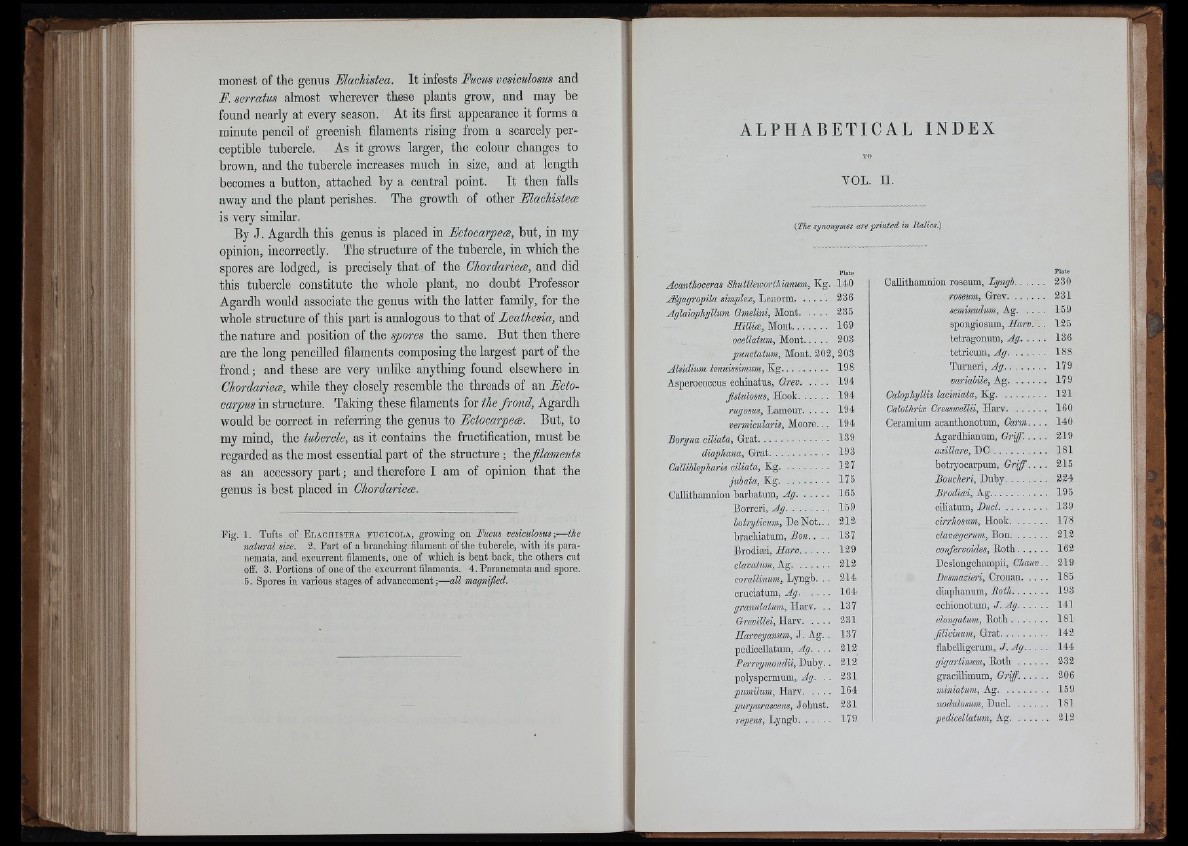
morest of the genus Elachistea. It infests Fucus vesiculosus and
F. serratus almost wherever these plants grow, and may be
found nearly at every season. At its first appearance it forms a
minute pencil of greenish filaments rising from a scarcely perceptible
tubercle. As it grows larger, the colour changes to
brown, and the tubercle increases much in size, and at length
becomes a button, attached by a central point. It then falls
away and the plant perishes. The growth of other Elachistea
is very similar.
By J. Agardh this genus is placed in Ectocarpecs, but, in my
opinion, incorrectly. The structure of the tubercle, in which the
spores are lodged, is precisely that of the Chordariea, and did
this tubercle constitute the whole plant, no doubt Professor
Agardh would associate the genus with the latter family, for the
whole structure of this part is analogous to that of Leathesia, and
the nature and position of the spores the same. But then there
are the long pencilled filaments composing the largest part of the
frond; and these are very unlike anything found elsewhere in
Chordariece, while they closely resemble the threads of an Ectocarpus
in structure. Taking these filaments for the frond, Agardh
would be correct in referring the genus to Ectoearpea. But, to
my mind, the tubercle, as it contains the fructification, must be
regarded as the most essential part of the structure; thefilaments
as an accessory p a rt; and therefore I am of opinion that the
genus is best placed in Chordariea.
Fig. 1. Tufts of E l a c h is t e a eticicola, growing on Fucus vesiculosus;— the
natural size. 3. Part of a branching filament of the tubercle, with its paranemata,
and excurrent filaments, one of which is bent back, the others cut
off. 3. Portions of one of the excurrent filaments. 4. Paranemata and spore.
5. Spores in various stages of advancement ;— all i
A L P H A B E T I C A L I N D E X
VOL. I I.
{The synonymes are p ñ n ted in Italics.)
Plate
Acanthoceras Shuttletvoriliianum, Kg. 140
JEgagropila simplex, Lenorm............. 236
Aglaiophyllum. Gmelini, Mont 335
Hüliæ, Mont.............. 169
ocellatum, Mont 303
punctatum, Mont. 203, 303
Alsidium tenuissimum. Kg.................. 198
Asperococcus echinatus, Grev 194
IS, Hook 194
IS, Lamour..... 194
ris, Moore... 194
( ciliata, Grat............................ 139
, Grat................... 193
s ciliata. Kg.................... 137
,K g ............... 175
Callithamnion barbatum, Ai/........ 165
Borreri, A g................. 159
hotrytkum, B e N o t ... 313
bracbiatum, B o n .. . . 137
Brodiæi, Harv 139
clavatum, Ag............... 312
corallinum, Lyngb. . . 214
cruciatum, Ag 164
», Harv. .. 137
ei, Harv 231
J. Ag. . 137
pedicellatum, Ag. . . . 313
Perreymondii, D uby.. 313
polyspermum, Ag. . . 331
pumilum, Harv 164
pm-purascens, .lohnst. 231
repens, Lyngb 179
Plate
Callithamnion roseum, Lyngh 330
roseum, Grev............... 231
seminudum, Ag 159
spongiosum, Harv. .. 135
tetragonum, Ag 136
tetricum, A g............... 188
Turneri, Ag................ 179
variabile, Ag............... 179
Calophyllis laciniata. Kg.................... 131
Calothrix Cresswellii, Harv................ 160
Ceramium acanthonotum, Carm.. . . 140
Agardbianum, Griff. . . . . 319
axillare, D C ..................... 181
botryocarpum. Griff.. .. 215
Boucheri, Duby................ 234
Brodiæi, Ag...................... 195
ciHatum, Duel................... 139
cirrliosum. Hook............... 178
clavægerum. Bon............... 213
confervoides, E o tb 163
Deslongchampii, C /i« » .. 319
Desmazieri, Crouan 185
diaphanum, Roth.............. 193
echionotum, / . A g 141
elmigatum, R o th .............. 181
filicinutn, Grat.................. 142
fiabelligerum, J . Ag 144
gigartinum, Roth ........... 333
graciUimum, Griff. 206
miniatum, Ag.................... 159
nodulosum,lAxcl............... 181
pedicellatum, Ag............... 313